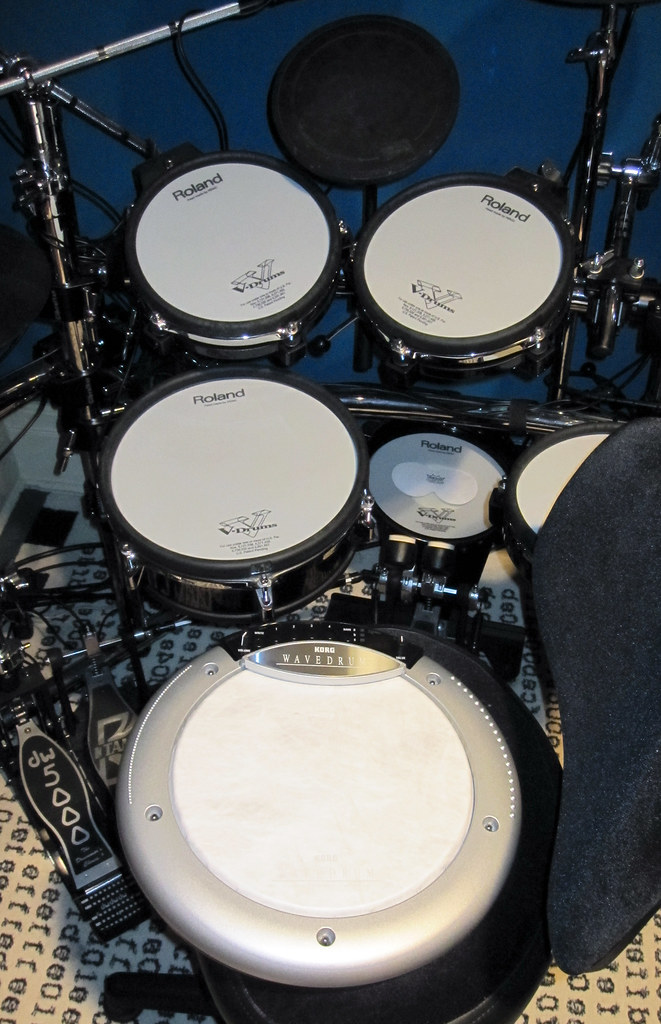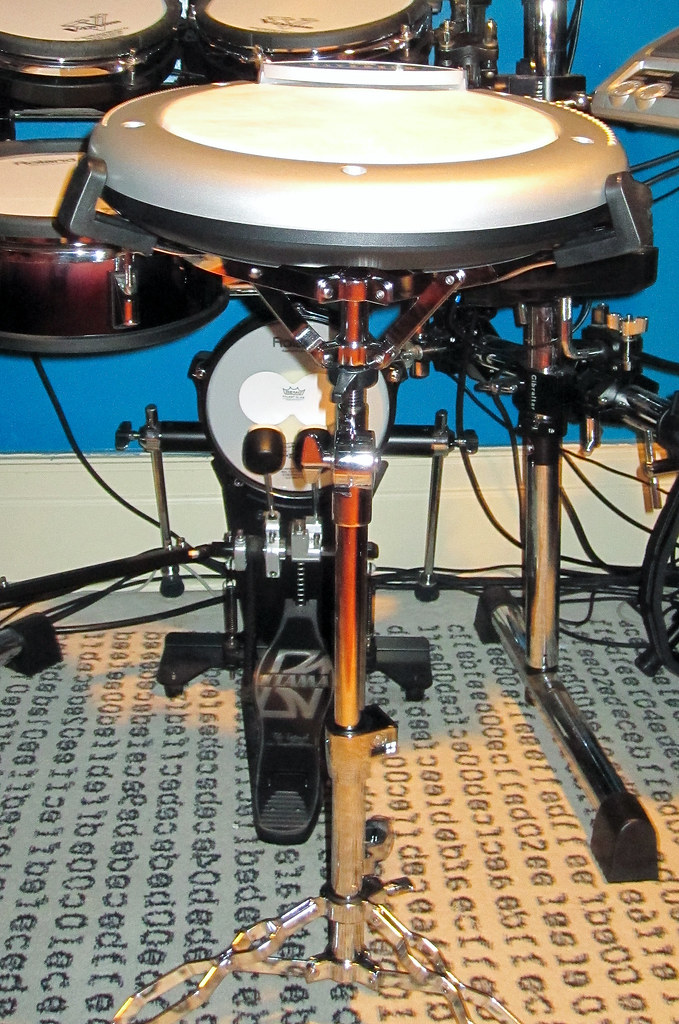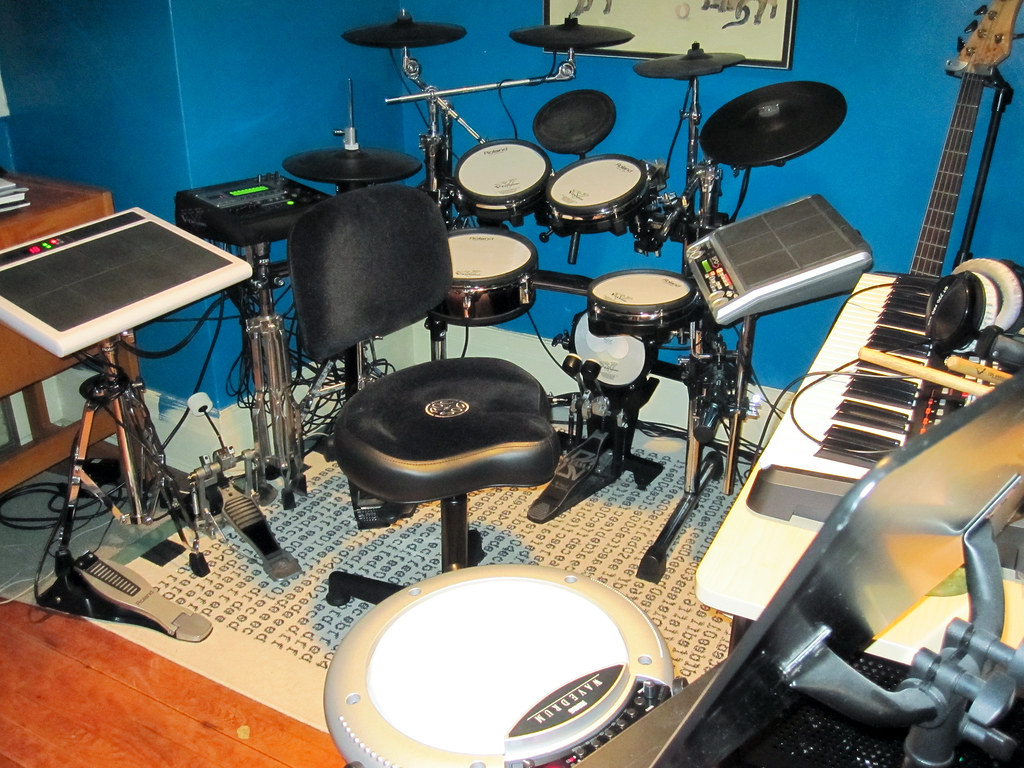This is the Synesthesia Mandala V2. Unlike the Korg Wavedrum there are no built-in sounds and all controls are software based. The only connection on the Mandala is a single USB 2.0 port.
As the name implies this is the second generation Mandala. I have not tried the first version, but my understanding is that the main difference is that that version 2 relies on software for all it's sounds and editing capabilities.
The Mandala comes with a power supply, a USB of reasonable length, a pair of 5B drum sticks and 2 CDs.
The first disc contains the Virtual Drum brain software and this is where all the heavy lifting is done. To get up and running on either Mac or PC you insert the first disc and copy over the software to a location on your computer. In this day and age a software installer which sets everything up should be standard, but even without it the install is very straight forward. The version that came with my Mandala was a version behind what is available on the website. I would suggest not installing from the CD and downloading the installer form the Synesthesia website.
I first tested on my main recording computer, a Windows XP Pro SP3 machine with a Profire 2626 interface. After installing the software you can plug the Mandala in and it's detected as a standard sound device under Windows. Once the software is installed you launch the Virtual Brain software and configure it's preferences. Here you will choose your audio driver, and which MIDI device is your Mandala. I chose my ASIO driver for my Profire 2626 and ran into a little difficulty selecting the correct MIDI device. This is not the Mandala's fault, but instead the fault of Microsoft not allowing naming of USB MIDI devices. Instead you see a generic USB MIDI (1), (2), etc. If you have a few MIDI devices you may to use trial and error to select the correct one. Once this was sorted out, I tested out some of the presets within the Virtual Brain software.
I found the pad to be responsive overall. It is not as responsive as a standard set of Roland Vdrums, but at this price point I don't think it's meant to be. I was able to control the pad as a I wanted when I set it for 3 zones. It would be nice to have some visual indicators on the pad separating the zones. 7 zones provided too small of a target for me, but that isn't to say that a person with better accuracy could not take advantage of the them.
There are a variety of presets which range from your typical drum and percussion sounds to various pitched instruments such as piano, bass, synths, etc. The pitched instruments allow you to control the scale, interval, pitch, and range. With the VB software you are in full control of many parameters including two sets of effects which allow for EQ, Compression, Flange, Delay, and various filters. You can control all these through MIDI as well. So for example depending on your the velocity with which you hit the pad you can affect delay lengths, filter, depth, etc. I've yet to really scratch the surface on all of these controls. The Virtual Brain software is setup so that you can add additional pads and they can all be controlled by a single instance of the software. There are slots for 4 additional pads in the software, but more slots can be added.
In order to record your performances you will need to use a program such as Virtual Audio Cable or Rewire to route the sounds to your DAW. It would be nice to make the VB into a VST in a future version.
Besides the VB software the Mandala comes with Control Burst and Battery III presets. Control Burst's sole purpose is to send a MIDI configuration to the Mandala which allows it to work with the provided Battery III presets and players. The Battery presets are custom presets that use the sample library which comes with Battery. I briefly tested the Battery presets and was pleasantly surprised to see that they all performed very well.
There is an additional download called Control Burst EXP. This version of the Control Burst program allows complete control over what MIDI information is sent form the Mandala. You would use this if you wanted to use the Mandala as a standard MIDI controller. I used this to configure a standard drumset which I used with Toontrack's Superior Drummer 2.0.
Disc 2 contains a program called Black Beauty and thousands of samples form the famous Ludwig Black Beauty snare drum. By installing these you can use your Mandala like a Black Beauty snare. I'm not sure how useful this will be for most people, but it is a nice addition and performed well.
The software is almost identical for Macs. I installed it on a Macbook Pro running 10.5.8 and all worked like it did on the PC.
There is very good documentation on the Synesthesia website, including PDFs, links to FAQs, and a community mailing list hosted on Google. I've contacted support several times, and have received answers within a few hours which clearly answered my questions.
I've been so busy tweaking the internal presets and sounds that I haven't gotten a chance to use my own samples, but the Mandala does have this capability as well.
Here is a video I made using the Mandala. It contains 3 zones, and is meant to be a standard II-V-I progression in Ab. Ironically the Mandala notates everything with sharps (#) so you can say this is in G# ;). It would be nice if the there was a simple "preset reset" feature so that when using scales you could start on a specific interval.
I'm not sure what Synesthesia has planned in the future, but it would be nice to see some a foot pedal that worked with the Mandala and Mandala software. In keeping with the spirit of the Mandala it could have 2 zones and allow you the same level of MIDI control as the Mandala.
Saturday, November 21, 2009
Sunday, November 15, 2009
Korg Wavedrum Videos
I was able to spend some time with the Wavedrum today and record some video. A few of the videos were recorded a little hot, but I think you can still see what it can do. For now, these are all system presets, except I changed the scale on Preset 50 to be the minor pentatonic scale. I'll have more details up during the week:
Saturday, November 14, 2009
Korg Wavedrum - Part I
I just received the Korg Wavedrum. I haven't had time to sit down and record any sound samples, but I did photograph the unpacking.
I will post a more detailed review in the next few days. For now I can say:
- The unit is very well built. The rim is metal.
- Unlike other electronic drums the head is an actual drum head (not mesh or rubber)
- Because it's a drum head this drum is noisy.
- Loading presets is slow. I imagine this is because of the DSP processing, but will need to investigate further.
This device can do a lot. The instruction manual is deceptively thin, but contains lots of information.
Not much to see here. Nice to see Korg hasn't updated it's packaging from the 90s.
The drum is packed well and easy to get out.
Comes with an instruction manual, Tuning key, and allen key which is used to adjust the sensor (more on that in Part II). Comes with a standard 9v wall wart power supply with what appears to be a
9ft cord.
Here is the bottom of the unit which is plastic. The rectangular cut out is where you adjust the sensor.
A closer look....
Here it is placed on top of a Roland SPD20.
Here it is relative to a Roland PD105, and PD85 pads.
The Wavedrum is a little more then 13 inches wide so any snare stand should hold it. One thing to note is that all the connections are in the 12 o'clock position, this is also where you would normally have your snare drum brace. You will need to work around this.
Here is the size relative to a 7yo. You could hold this on your lap and play it. I'll show this in part 2.
And finally with the rest of the family. Stay tuned for part 2.
Subscribe to:
Posts (Atom)










